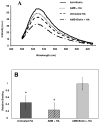Ligand-modified aminobisphosphonate for linking proteins to hydroxyapatite and bone surface
- PMID: 18001076
- PMCID: PMC3247143
- DOI: 10.1021/bc700196q
Ligand-modified aminobisphosphonate for linking proteins to hydroxyapatite and bone surface
Abstract
An increase in bone resorption is one of the main symptoms of osteoporosis, a disease that affects more and more individuals every day. Bisphosphonates are known to inhibit bone resorption and thus are being used as a treatment for osteoporosis. Aminobisphosphonates present a functionality that can be easily used for conjugation to other molecules, such as peptides, proteins, and ligands for protein recognition. In this study, an aminobisphosphonate conjugated with biotin was used as a model linker for protein attachment to bone. With this system, the interaction of biotinylated aminobisphosphonate with hydroxyapatite, a major mineral component of bone, was investigated. Quantification of the binding of aminobisphosphonate to hydroxyapatite was performed using a fluorescently labeled antibody for biotin. Additionally, the interaction of the biotinylated aminobisphosphonate with multiple treatments of cortical bone from the midshaft of a cow femur was studied. It was demonstrated that modified aminobisphosphonate reagents can bind hydroxyapatite and bone at high levels, while the biotin functionality is free to be recognized by the fluorescently labeled antibiotin antibody, suggesting that modified aminobisphosphonates could be used to link other peptides or proteins to the bone surface.
Figures






Similar articles
-
Evaluation of the interaction between hydroxyapatite and bisphosphonate by nonlinear capillary electrochromatography.J Sep Sci. 2017 May;40(9):2030-2036. doi: 10.1002/jssc.201700028. Epub 2017 Mar 27. J Sep Sci. 2017. PMID: 28244204
-
Bisphosphonate conjugation to proteins as a means to impart bone affinity.Biotechnol Prog. 2000 Mar-Apr;16(2):258-67. doi: 10.1021/bp990154m. Biotechnol Prog. 2000. PMID: 10753453
-
A comparison of the binding of biotin and biotinylated macromolecular ligands to an anti-biotin monoclonal antibody and to streptavidin.J Immunol Methods. 1993 Oct 15;165(2):177-82. doi: 10.1016/0022-1759(93)90343-6. J Immunol Methods. 1993. PMID: 8228268
-
Interactions between Clinically Used Bisphosphonates and Bone Mineral: from Coordination Chemistry to Biomedical Applications and Beyond.ChemMedChem. 2018 Feb 20;13(4):289-302. doi: 10.1002/cmdc.201700769. Epub 2018 Jan 30. ChemMedChem. 2018. PMID: 29323467 Review.
-
[Bisphosphonate therapy in osteoporosis. Inhibition of trabecular perforation by aminobisphosphonate].Fortschr Med. 1997 Oct 20;115(29):37-42. Fortschr Med. 1997. PMID: 9445833 Review. German.
Cited by
-
Self-protecting bactericidal titanium alloy surface formed by covalent bonding of daptomycin bisphosphonates.Bioconjug Chem. 2010 Nov 17;21(11):1978-86. doi: 10.1021/bc100136e. Epub 2010 Oct 15. Bioconjug Chem. 2010. PMID: 20949909 Free PMC article.
-
Synthesis of Amino-gem-Bisphosphonate Derivatives and Their Application as Synthons for the Preparation of Biorelevant Compounds.Pharmaceuticals (Basel). 2025 Jul 18;18(7):1063. doi: 10.3390/ph18071063. Pharmaceuticals (Basel). 2025. PMID: 40732350 Free PMC article. Review.
-
Enhanced affinity bifunctional bisphosphonates for targeted delivery of therapeutic agents to bone.Bioconjug Chem. 2011 Dec 21;22(12):2496-506. doi: 10.1021/bc2003132. Epub 2011 Dec 5. Bioconjug Chem. 2011. PMID: 22073906 Free PMC article.
References
-
- Kiberstis P, Smith O, Norman C. Bone health in the balance. Science. 2000;289:1497.
-
- Ducy P, Schinke T, Karsenty G. The osteoblast: A sophisticated fibroblast under central surveillance. Science. 2000;289:1501–1504. - PubMed
-
- Teitelbaum SL. Bone Resorption by Osteoclasts. Science. 2000;289:1504–1508. - PubMed
-
- Rodan GA, Martin TJ. Therapeutic approaches to bone diseases. Science. 2000;289:1508–1514. - PubMed
-
- Finkelstein JS. Calcium plus vitamin D for postmenopausal women -bone appetit? N Engl J Med. 2006;354:750–751. - PubMed
Publication types
MeSH terms
Substances
Grants and funding
LinkOut - more resources
Full Text Sources
Other Literature Sources

